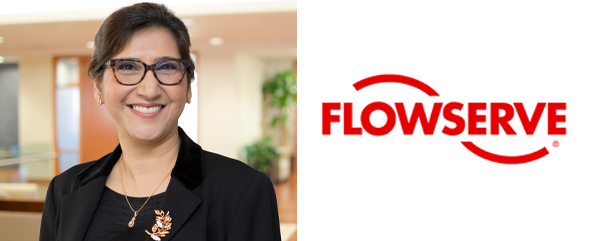
Tauseef Salma is vice president, global marketing and technology at Flowserve and recently provided industry insight to Pumps & Systems. She has more than 23 years of multifunctional, global experience across the oil and gas and industrial sectors. Salma earned a Ph.D. in chemical engineering from Rice University, holds four patents and has authored more than 20 publications.
What are the biggest shifts that have taken place in your industry or other applicable pumping industries during the past few years?
Three shifts have had significant impacts upon the flow control industry:
- Digitalization — Increased access to data, enhanced computational capability and the utilization of data create operational information. Those data-driven insights enable operators to take corrective or preventative action to reduce the operating and lifecycle costs of pumps. This is also leading to changes in business models and shifting the value from physical equipment to volume of flow (throughput) and uptime.
- Diversification of demand — The pumping industry has the largest (and aging) installed base in North America and Europe. With a population increase in the East, the demand for flow as well as investment in flow has changed magnitude, with a large percentage of the spend coming from China. This impacts manufacturing footprints, localization and design standardization, among other things.
- Decarbonization — Pumps utilize energy to mobilize liquids. The energy needed by pumps was in large part supplied by fossil fuels. But during the past 20 years, there has been a change from fossil fuel to renewables. COVID-19 further accelerated this transition, which is expected to continue in the coming decade.
In addition to digitalization and population-driven shifts, energy transition will drive massive changes in flow requirements and the flow control industry and hence the pumping industry. Energy transitions have already occurred: from coal to oil, to shale oil, and now to gasification and to renewables. Each transition affected multiple nodes within the value chain, such as the:
- type of working fluids used to generate power
- volume of fluids moved
- process and distances across which fluids were mobilized
- modes and magnitude of energy storage
- infrastructure investments needed
- technologies and skill requirements
- safety and reliability considerations
- economics in the value chain
- geopolitical considerations
How has your company positioned itself through these changes?
Flowserve has been on a transformational journey called Flowserve 2.0. Since 2018, we have made concerted efforts to focus on operational excellence, digitalization, the customer experience and aligning our strategy to strengthen our core business. At the same time, we’re focused on enabling energy transition for our customers and targeting growth in new and emerging segments through diversification, digitalization and technology investments.
Along with this business strategy, we are aligning our investments in order to achieve our environmental, social and governance (ESG) targets.
How has the workforce changed as a result of the COVID-19 pandemic, and have the vaccines made a difference?
Our workforce became more virtual as well as more agile. But despite limitations in terms of mobility and in-person collaboration, our teams at Flowserve leaned in and continued our transformational journey toward operational excellence and digitalization for a better customer experience. Some examples from the past 12 months include:
- Developing the right seals to go onto pumps used in vaccine manufacturing
- Reducing carbon emissions through our new and enhanced vacuum technology for flue gas systems
- Designing new hydraulics to achieve higher efficiency for pumps in the midstream sector
- Launching RedRaven, an internet of things (IoT) ecosystem for monitoring, diagnostics, improved safety, reliability and reduced cost of pumps and flow control operations
Vaccine access has varied by geography. Where available (e.g., in North America and Europe), it has definitely reduced safety concerns and improved ease of movement. Overall, Flowserve’s workforce has remained focused and committed to serving our customers and creating flow control solutions to make the world better for everyone.
What are the biggest industry challenges that lie ahead?
Some of the biggest industry challenges as well as opportunities lie in energy transition with the necessity to decarbonize safely, cost-effectively and in a timely manner. Examples range from efficient solutions to address the increased intensity in material movement in the mining sector to:
- Developing environmentally friendly ways of recycling batteries
- Scaling the right hydrogen or carbon capture solutions
- Supplying water to water-stressed areas
In addition, the speed of adoption for digital solutions has yet to be determined, especially in fossil fuel-based industry sectors.
What are you most looking forward to as it pertains to the industry in the future?
There are tremendous opportunities in the technology domain to bring the digital to the physical — from design to delivery and across the value chain. I am most looking forward to the acceleration in the use of data-driven, actionable intelligence to reduce the overall cost of operations; reduce carbon emissions; and improve the health, safety and environmental impact within our industry.
I also look forward to adoption of new technologies that can reduce cycle times, help us achieve sustainability goals, increase customer value, and realize a higher return on our investments.
What keeps you up at night?
As the energy transition impacts many of our core markets, what keeps me up at night is contemplating what we are not investing in that may emerge to be a scalable solution. Also, how do we resource each selected lane of execution for maximum customer value and optimum outcomes for Flowserve?


